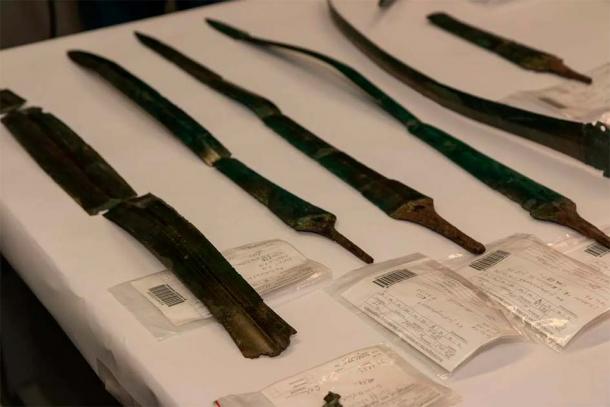
Fearsome Swords and Fascinating Hoards Unearthed in Pomerania, Germany
In an extraordinary display of historical significance, volunteer archaeologists in Mecklenburg-Western Pomerania have uncovered three remarkable finds from the past, as announced by the State Office for Culture and Monument Preservation (LAKD) on Wednesday. These treasures include seven Bronze Age swords, a hoard of 6,000 silver coins from the 11th century, and a unique treasure trove with a reliquary container, also dating back to the 11th century.
Culture Minister Bettina Martin praised the efforts of the region's volunteer archaeological preservationists during the presentation of the finds. With around 250 active volunteers and an equal number undergoing training, Martin emphasized their crucial role in safeguarding Mecklenburg-Western Pomerania's cultural heritage. She expressed her gratitude, noting that these significant discoveries were possible thanks to their dedication.
- Experiment Reveals Secrets to Brutal Bronze Age Warfare
- Relics of Fallen Warriors in Germany Reveal Secrets of Bronze Age Battle

The 3,000-year-old swords found in fragments in Mirow. (Mecklenburg Ministry of Culture)
Bronze Age Swords of the Germanic Region
The seven swords, found in fragments near Mirow in the Mecklenburg Lake District, are believed to have resurfaced during a trench dredging operation and scattered over a larger area with the dredged material. The volunteers meticulously located the individual fragments, allowing for almost complete reconstruction of the swords.
Experts suggest that these swords were likely submerged in the lowlands as consecration or sacrificial offerings. This discovery marks the largest collection of Bronze Age swords found in one location in Mecklenburg-Western Pomerania, dating back approximately 3,000 years.
The story of Bronze Age swords in Germany is a fascinating chapter in the wider story of European prehistory. Dating back to around 1600 to 1200 BC, these swords mark a significant evolution in weaponry and metallurgical skills.
The Bronze Age in Germany was characterized by the widespread use of bronze, an alloy of copper and tin, which was harder and more durable than the previously used copper. This technological advancement led to the production of stronger and more effective swords, which were not only weapons but also symbols of power and status.
The Bronze Age was a turbulent time in this region, with much conflict. Famously, in Tollense Valley, not far from the site of the latest find, was the site of Europe’s oldest evidenced battle, at 3,300 years ago. Recently, local authorities of Mecklenburg reclassified it as the site of a massacre, based on the evidence of the hundreds of corpses including women and children found there.
- Archaeologists Discover Tollense Battle Was Actually A Massacre
- Scientists Discover Clues to Identities of Mystery Warriors Lying on an Ancient Battlefield
Hoard of 11th-century Coins
Another remarkable find was made on Rügen, where 6,000 silver coins from the 11th century were unearthed, mostly contained in a clay pot. The "De Ackerlöper" working group of volunteer conservationists made this discovery. The coins, hailing from various regions including western Germany, Meißen-Upper Lusatia, England, Denmark, Bohemia, and Hungary, point to diverse trade relationships of that era. This find is considered the largest Slavic coin hoard to be found in the post-war period.

Many pieces of jewelry and containers were also found. (Mecklenburg Ministry of Culture)
The third significant find includes the reliquary containers discovered in the Mecklenburg Lake District by a volunteer conservationist. Hidden within a pot of around 1,700 coins were neck and finger rings, a pearl necklace comprising gold, rock crystal, and carnelian beads, and two uniquely shaped reliquary containers. These containers, one resembling a kaptorga (necklace box) and the other a crucifix, stand as rare evidence of Christian faith in a region predominantly influenced by other beliefs at the time.
These discoveries not only highlight the rich historical tapestry of Mecklenburg-Western Pomerania but also underscore the invaluable contribution of volunteer archaeologists in uncovering and preserving the world’s heritage.
Top image: State archaeologist Dr. Detlef Jantzen holds examines a Bronze Age sword at the presentation of the find.Source: Mecklenburg Ministry of Culture
By Gary Manners
References
Altuntas, Leman, Nov 2023. ‘In Germany, volunteers unearthed the largest hoard of Slavic coins to date and bronze-age seven swords’. Arkeonews. Available at: https://arkeonews.net/in-germany-volunteers-unearthed-the-largest-hoard-of-slavic-coins-to-date-and-bronze-age-seven-swords/
WKM MV Press release, Nov 2023. ‘Evidence of times gone by State Office for Culture and Monument Preservation presents extraordinary finds’ Mecklenburg-Vorpommern. Available at: https://www.regierung-mv.de/Landesregierung/wkm/Presse/Pressemitteilungen/?id=196662&processor=processor.sa.pressemitteilung















